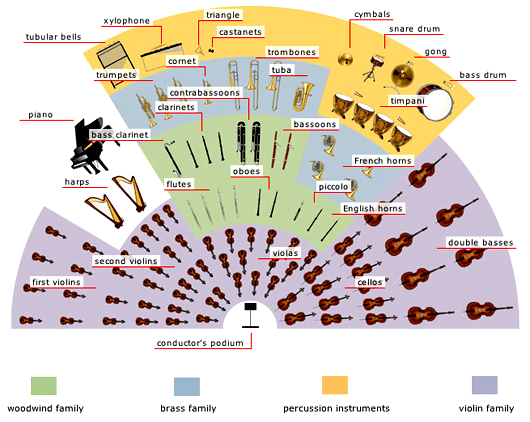Mahler Symphony 2
I am in the process of finishing the 2nd symphony section and will be update this page as things get finished so check back soon.
Program: Mahler's 2nd
The following program was written by Mahler for a performance of his 2nd symphony that took place in Dresden 1901.
First Movement: Allegro maestoso
“We are standing near the grave of a well loved man. His whole life, his struggles, his sufferings and his accomplishments on earth pass before us. And now, in this solemn and deeply stirring moment, when the confusion and distractions of everyday life are lifted like a hood from our eyes, a voice of awe-inspiring solemnity chills our heart, a voice that, blinded by the mirage of everyday life, we usually ignore: “What next?” it says. “What is life and what is death? Will we live on eternally? Is it all an empty dream or do our life and death have a meaning?” And we must answer this question, if we are to go on living. The next three movements are conceived as intermezzi.
Second Movement: Andante
"A blissful moment in the dear departed’s life and a sad recollection of his youth and lost innocence."
Third Movement: Scherzo
A spirit of disbelief and negation has seized him. He is bewildered by the bustle of appearances and he loses his perception of childhood and the profound strength that love alone can give. He despairs both of himself and of God. The world and life begin to seem unreal. Utter disgust for every form of existence and evolution seizes him in an iron grasp, torments him until he utters a cry of despair.
Fourth Movement: Alto solo. ‘Urlicht’ (Primeval Light) – from the Knaben Wunderhorn
The stirring words of simple faith sound in his ears: “I come from God and I will return to God!”
Fifth Movement: Aufersteh'n
Once more we must confront terrifying questions, and the atmosphere is the same as at the end of the third movement. The voice of the Caller is heard. The end of every living thing has come, the last judgment is at hand and the horror of the day of days has come upon us. The earth trembles, the graves burst open, the dead arise and march forth in endless procession. The great and the small of this earth, the kings and the beggars, the just and the godless all press forward. The cry for mercy and forgiveness sounds fearful in our ears. The wailing becomes gradually more terrible. Our senses desert us, all consciousness dies as the Eternal Judge approaches. The last trump sounds; the trumpets of the Apocalypse ring out. In the eerie silence that follows, we can just barely make out a distant nightingale, a last tremulous echo of earthly life. The gentle sound of a chorus of saints and heavenly hosts is then heard: “Rise again, yes, rise again thou wilt!” Then God in all His glory comes into sight. A wondrous light strikes us to the heart. All is quiet and blissful. Lo and behold: there is no judgment, no sinners, no just men, no great and no small; there is no punishment and no reward. A feeling of overwhelming love fills us with blissful knowledge and illuminates our existence.”
Text
Fourth Movement: Urlight (Primal Light)
|
Fifth Movement: Aufersteh'n (Resurrection)
|
Instrumentation

The symphony is written for an orchestra, a mixed choir, two soloists (soprano and contralto), organ, and an offstage ensemble of brass and percussion. The use of two tam-tams, one pitched high and one low, is particularly unusual; the end of the last movement features them struck in alternation repeatedly.
This was taken from wikipedia:
Woodwind
- 4 Flutes {Flöte, Fl.}, alternating on 4 Piccolos
- 4 Oboes {Oboe, Ob.}, two alternating on 2 English Horns {Engl. Horn}
- 3 Clarinets {Clarinette, Clar.} in B-flat, A, C, one alternating on Bass Clarinet {Bass-Clarinette, Basscl.} (B flat)
- 2 E-flat Clarinets, one alternating on Clarinet (both doubled in ff where possible)
- 3 Bassoons {Fagott, Fag.}
- 1 Contrabassoon {Contra-Fagott, Contrafg.}, alternating on Bassoon
Brass
- 10 Horns {Horn} in F, four used offstage {in der Ferne}
- 8-10 Trumpets {Trompete, Trmp.} in F and C, four to six used offstage
- 4 Trombones {Posaune, Pos.}
- 1 Contrabass-Tuba {Contrabasstuba, Tuba}
Percussion
Percussion requires total of 7 players.
- 7 Timpani {Pauken}, six (three players) onstage, one offstage
- 2 pairs of Cymbals {Becken}, one offstage
- 2 Triangles {Triangel}, one offstage
- Side Drum {Kleine Trommel, Kl. Tr.} (more than one, where possible)
- Glockenspiel
- 3 Bells {Glocken} (steel rods with deep, unpitched sound)
- 2 Bass Drums {Grosse Trommel, Gr. Tr.}, one offstage, with Switch {Ruthe}
- 2 Tam-tams {Tam-Tam} (high and low)
Keyboards
- Organ {Orgel}
Voices
- Soprano solo {Sopran-Solo, Sopr. Solo}
- Alto solo {Altstimme, Altst., Alt. Solo}
- Sopranos {Soprane, Sopr.}
- Altos {Alte, Alt.}
- Tenors {Tenore, Ten.}
- Basses {Basse, Bass}
Strings
"Largest possible contingent of all strings"
- Harps {Harfe} I, II (several per part)
- Violins {Violine, Viol.} I, II
- Viola {Viola}
- Cellos {Violoncello, Cello}
- Double Basses {Contrabass, Bass} (several with low C string)
This instrumentation was taken from the following book:
Mahler, Gustav. 1988. Symphonies Nos 1 and 2 in Full Score. Dover Publications Inc. ISBN-10: 0486254739 page 170.
Premieres
- World premiere (first three movements only): March 4, 1895, Berlin, with the composer conducting the Berlin Philharmonic.
- World premiere (complete): December 13, 1895, Berlin, conducted by the composer.
- Dutch premiere: October 26, 1904, Amsterdam, with the composer conducting the Concertgebouw Orchestra.
- American premiere: December 8, 1908, New York City, conducted by the composer with the New York Symphony Orchestra.
- Recording premiere: 1924, Oskar Fried conducting the Berlin State Opera Orchestra.
- British premiere: April 16, 1931, London, conducted by Bruno Walter.